 Lawrence Randolph Hafstad (1904 - October 12, 1993), was a physicist who played an important role in the development of nuclear power plants
Lawrence Randolph Hafstad (1904 - October 12, 1993), was a physicist who played an important role in the development of nuclear power plants
Dr. Hafstad was with the Carnegie Institution of Technology in Washington when word came that German scientists had succeeded in splitting atomic nuclei in the late 1930's. Working with technology and equipment he had developed with two colleagues, Dr. Richard Roberts and Dr. Merle Tuve, he accomplished the same feat in this country in 1939. Their achievement was the first step toward the production and use of the atomic bomb in 1945.
Dr. Hafstad was also in the forefront of the development of nuclear reactors. In 1950 he was with a new program, led by Adm. Hyman Rickover, to build a nuclear engine for submarines.
In 1940, Dr. Hafstad took a leave of absence from the Carnegie Institution to become a top executive in the Office of Scientific Research and Development. The agency was created by President Franklin D. Roosevelt to marshal the scientific and technical talent and laboratories to work for the armed forces. More Accurate Artillery
In 1942 he became assistant director of the Applied Physics Laboratory of Johns Hopkins University. Then he led a project that made a variable-time fuse to explode artillery shells as they neared their targets.
The variable-time radio-proximity fuse was given some credit for the Allied victory in the Battle of the Bulge. It made anti-aircraft and artillery fire more accurate. The Germans had tried and failed in a parallel program. Other projects Dr. Hafstad worked on included supersonic ramjet engines and guided missiles.
Having joined the laboratory as assistant director, he succeeded Dr. Tuve as its director of research in 1946. He left Johns Hopkins in 1947.
He subsequently served as executive secretary of the Government's Joint Research and Development Board that coordinated all military research and development. In 1948 he was appointed the first director of reactor development for the Atomic Energy Commission.
In 1955, he became a vice president at the General Motors Corporations and was chief of its research laboratories. He stayed there until his retirement in 1969. At the same time, he was chairman of the A.E.C.'s General Advisory Committee. After leaving General Motors he headed the committee on undersea warfare for the National Academy of Sciences until 1972.
Although he was deeply involved in military ordnance throughout his career, he was also an outspoken advocate of the peaceful uses of nuclear power. He believed that nuclear power became practical solely because of military demand for it.
"In fact," he told an interviewer in 1950, "the history of technological development is replete with examples of civilian devices the development costs of which were borne by the military."
Dr. Hafstad was born in Minneapolis, the son of Norwegian immigrants. He worked his way through the University of Minnesota, graduating in electrical engineering. He earned his Ph.D. in physics at Johns Hopkins in 1933.
He had began working with the Carnegie Institution from 1928. Among his concerns there were high-voltage vacuum tubes. He took part in the first precision measurements of the scattering of protons by protons.